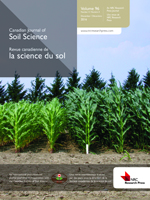Roy, A. K., Wagner-Riddle, C., Deen, B., Lauzon, J. and Bruulsema, T. 2014. Nitrogen application rate, timing and history effects on nitrous oxide emissions from corn (Zea mays L.). Can. J. Soil Sci. 94: 563-573. Nitrous oxide (N2O) emissions resulting from application of nitrogen (N) fertilizer contribute to the greenhouse gas footprint of corn production. In eastern Canada, corn is a major crop with most N fertilizer applied pre- or at planting. This timing of application results in a lack of synchrony of soil N supply and crop N demand. Matching the amount and timing of application to crop uptake has been suggested as a mitigation measure to reduce N losses, and is an integral part of the 4R Nutrient Stewardship program. This study examined the effect of timing, rate and history of urea-ammonium nitrate application on N2O emissions in corn in 2011 and 2012 at Elora, ON, Canada. Treatments were three N rates (30, 145 and 218 kg N ha-1); two timings (N injected in mid-row at planting and at the 8th leaf stage, V8); two histories (short-term: applying N rate treatments on plots that had received 145 kg N ha-1 in the previous year, and long-term: applying the same N rate to a given plot over the duration of the trial). N2O emissions were measured using static chambers. History of N application did not have an effect on N2O emissions or grain yield. In both years, cumulative N2O emissions during the growing season and corn yields increased significantly with increasing N application rates. In 2011, cumulative N2O emissions were significantly lower when N was applied as side-dress at V8 (0.88 kg N ha-1) compared with planting (2.12 kg N ha-1), with no significant impact on corn grain yield (average 9.1 Mg ha-1). In contrast, in 2012, limited rainfall reduced both N2O emissions and corn grain yield, and neither N2O emission (average 0.17 kg N ha-1) nor grain yield (average 6.7 Mg ha-1) was affected by timing of N application. Applying N as side-dress at V8 instead of at planting and using the recommended N rate were shown to be effective N2O emission mitigation practices without affecting corn yield during a typical wet spring in Ontario.
How to translate text using browser tools
15 July 2014
Nitrogen application rate, timing and history effects on nitrous oxide emissions from corn (Zea mays L.)
Amal K. Roy,
Claudia Wagner-Riddle,
Bill Deen,
John Lauzon,
Tom Bruulsema
ACCESS THE FULL ARTICLE
It is not available for individual sale.
This article is only available to subscribers.
It is not available for individual sale.
It is not available for individual sale.
<
Previous Article
|

Canadian Journal of Soil Science
Vol. 94 • No. 4
August 2014
Vol. 94 • No. 4
August 2014
antécédents de fertilisation N
Application timing
corn yield
Émissions d'oxyde nitreux
épandage en bandes latérales
moment d'application
N fertilizer history




